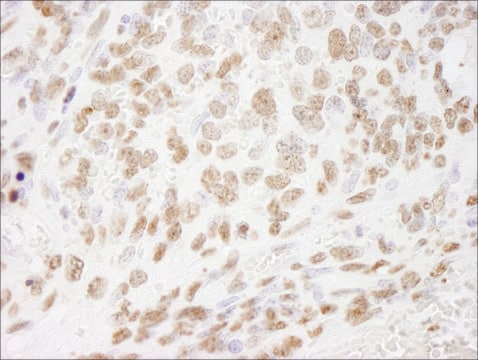14-856
Ubiquitin C-terminal hydrolase L3 (UCH-L3), 50 µg
From human cDNA, expressed in E. coli. Ubiquitin C-terminal hydrolases are a family of cysteine hydrolases that catalyze the hydrolysis of amides, esters & thioesters of the C-terminus of ubiquitin.
Sign Into View Organizational & Contract Pricing
All Photos(1)
About This Item
UNSPSC Code:
12352200
eCl@ss:
32160405
NACRES:
NA.32
Recommended Products
biological source
human
Quality Level
recombinant
expressed in E. coli
specific activity
>1000 pmol/min-μg, 25 °C (with 1 μM ubiquitin-AMC as substrate and UCH-L3 at 20 pM (0.58 ng/mL).)
mol wt
Mw 26.2 kDa
manufacturer/tradename
Upstate®
NCBI accession no.
UniProt accession no.
shipped in
dry ice
General description
Produced from human cDNA, expressed in E. coli. Ubiquitin C-terminal hydrolases (UCHs) are a family of cysteine hydrolases that catalyze the hydrolysis of amides, esters and thioesters of the C-terminus of ubiquitin. UCH-L3 is a member of the lower molecular weight group of UCHs involved in the hydrolysis of small C-terminal derivatives of ubiquitin that form non-specifically during the process of protein ubiquitinylation.
Product Source: Recombinant human UCH-L3 expressed in E.coli.
Application
From human cDNA, expressed in E. coli. Ubiquitin C-terminal hydrolases are a family of cysteine hydrolases that catalyze the hydrolysis of amides, esters & thioesters of the C-terminus of ubiquitin.
Storage and Stability
Store at -70°C for up to 12 months from date of receipt. As supplied, the enzyme is stable on ice for several hours. Activity is stable up to 6 freeze/thaw cycles (snap freezing in a dry/ice ethanol bath or liquid nitrogen).
Legal Information
UPSTATE is a registered trademark of Merck KGaA, Darmstadt, Germany
Disclaimer
Unless otherwise stated in our catalog or other company documentation accompanying the product(s), our products are intended for research use only and are not to be used for any other purpose, which includes but is not limited to, unauthorized commercial uses, in vitro diagnostic uses, ex vivo or in vivo therapeutic uses or any type of consumption or application to humans or animals.
Storage Class Code
12 - Non Combustible Liquids
WGK
WGK 1
Flash Point(F)
Not applicable
Flash Point(C)
Not applicable
Certificates of Analysis (COA)
Search for Certificates of Analysis (COA) by entering the products Lot/Batch Number. Lot and Batch Numbers can be found on a product’s label following the words ‘Lot’ or ‘Batch’.
Already Own This Product?
Find documentation for the products that you have recently purchased in the Document Library.
L J Kurihara et al.
Molecular and cellular biology, 20(7), 2498-2504 (2000-03-14)
Mice homozygous for the s(1Acrg) deletion at the Ednrb locus arrest at embryonic day 8.5. To determine the molecular basis of this defect, we initiated positional cloning of the s(1Acrg) minimal region. The mouse Uch-L3 (ubiquitin C-terminal hydrolase L3) gene
K D Wilkinson et al.
Journal of molecular biology, 291(5), 1067-1077 (1999-10-16)
The ubiquitin fold is a versatile and widely used targeting signal that is added post-translationally to a variety of proteins. Covalent attachment of one or more ubiquitin domains results in localization of the target protein to the proteasome, the nucleus
Shahram Misaghi et al.
The Journal of biological chemistry, 280(2), 1512-1520 (2004-11-09)
Ubiquitin C-terminal hydrolases (UCHs) comprise a family of small ubiquitin-specific proteases of uncertain function. Although no cellular substrates have been identified for UCHs, their highly tissue-specific expression patterns and the association of UCH-L1 mutations with human disease strongly suggest a
Roles of ubiquitinylation in proteolysis and cellular regulation
Wilkinson, K D
Annual Review of Nutrition, 15, 161-189 (1995)
Kinetic and mechanistic studies on the hydrolysis of ubiquitin C-terminal 7-amido-4-methylcoumarin by deubiquitinating enzymes.
Dang, L C, et al.
Biochemistry, 37, 1868-1879 (1998)
Our team of scientists has experience in all areas of research including Life Science, Material Science, Chemical Synthesis, Chromatography, Analytical and many others.
Contact Technical Service







